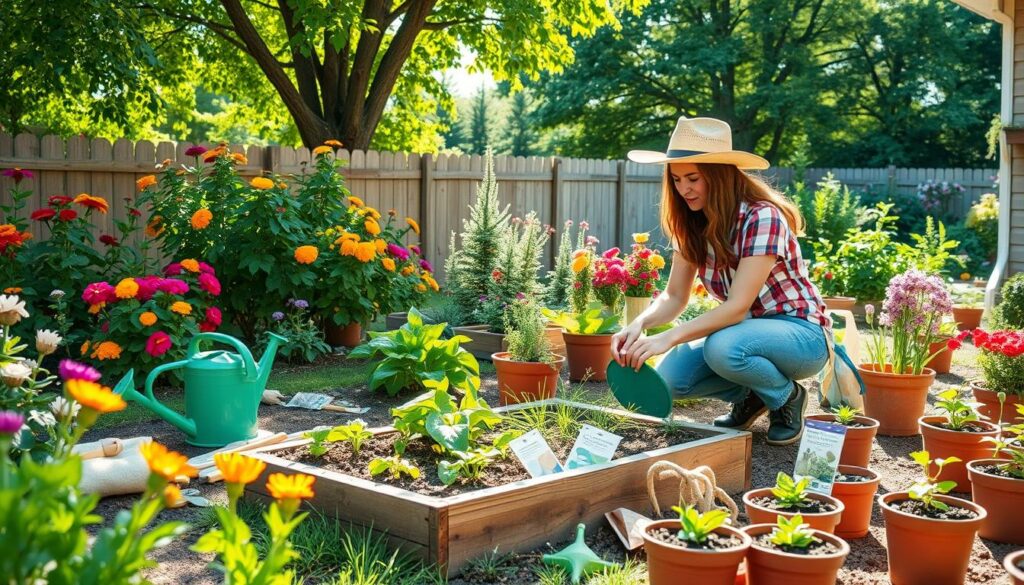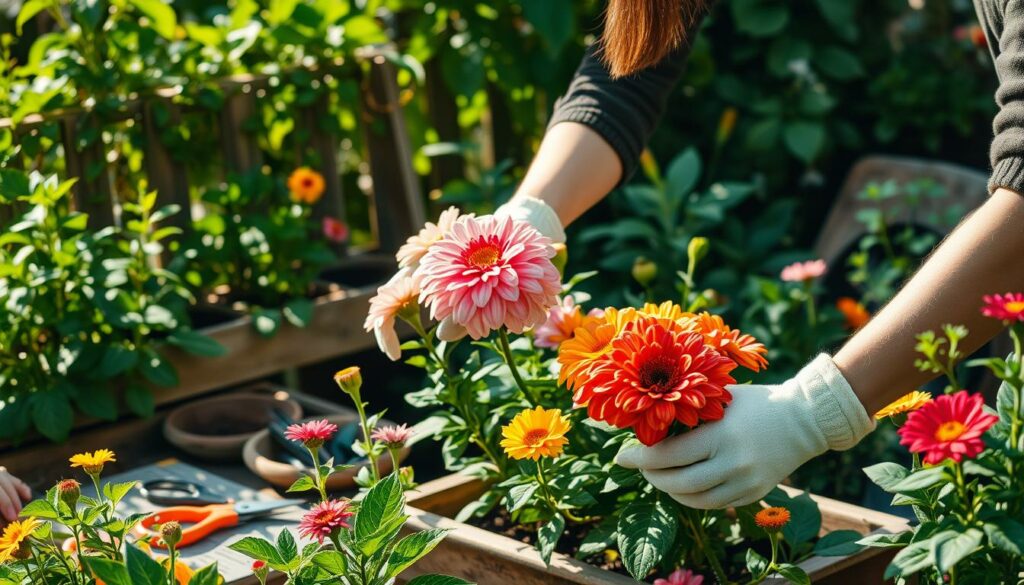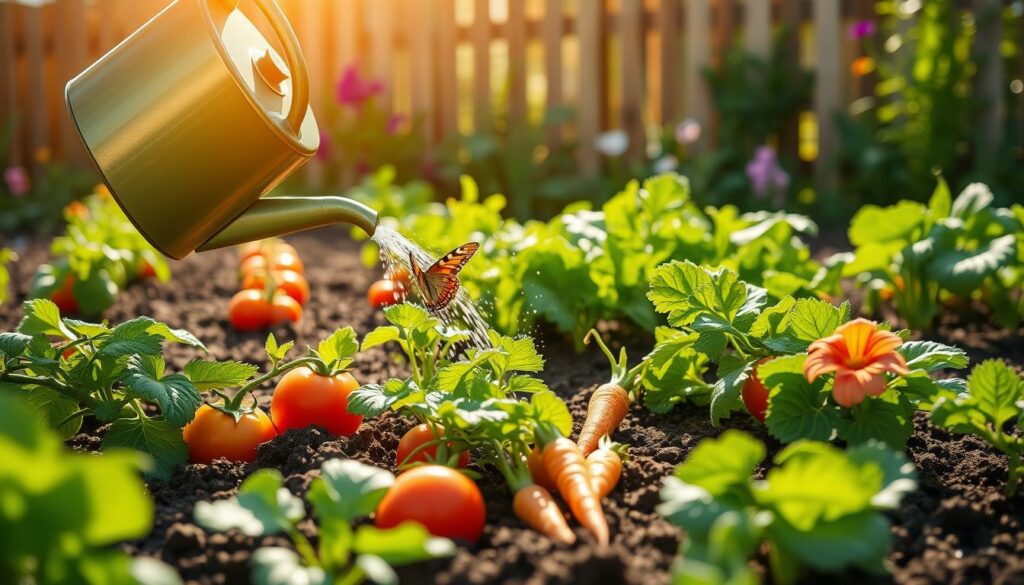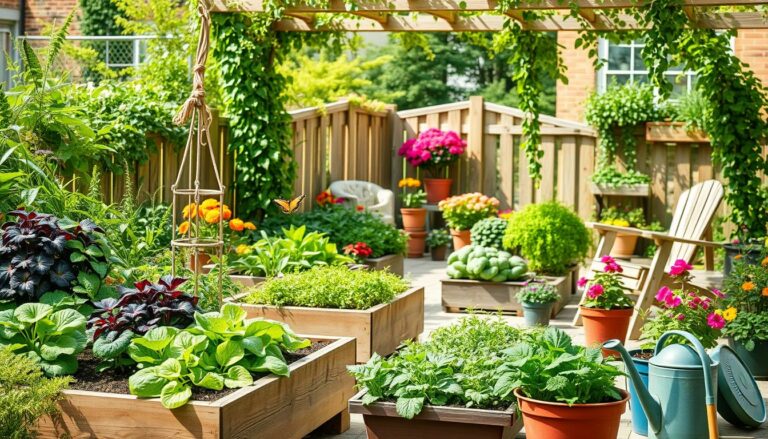Discover the secrets to a thriving home garden with this guide. It’s perfect for both seasoned gardeners and beginners. You’ll learn how to turn your outdoor space into a lush oasis. This article covers everything from soil preparation to organic pest control.
Explore the importance of soil health and how to fix tough soil. Learn the art of pruning and deadheading to keep your plants looking great. Find out the best ways to water and fertilize for growth and harvests. This guide is for anyone starting a garden or looking to improve their skills.
Key Takeaways
- Discover the essential tips and tricks for successful home gardening
- Learn how to master soil preparation and revive struggling plants
- Explore organic weed and pest control methods to maintain a healthy garden
- Understand your growing zone and optimize plant selection for your climate
- Uncover the secrets to pruning, deadheading, watering, and soil care
Mastering Soil Preparation
Starting a thriving home garden begins with soil preparation. Whether your soil is soggy or compacted, improving it is key. This can greatly impact your plants’ success.
Amending Soggy Soils
Dealing with too much water is common. But, you can fix it. Add soil amendments like compost to help with soil drainage. Building raised planting beds on gravel also improves drainage and keeps plants up high.
For ongoing soggy soil problems, French drains might be the answer. These systems move water away from your plants. Before planting, check your garden’s drainage to spot and fix any issues.
“Healthy, well-draining soil is the foundation for a thriving home garden. Take the time to properly prepare and amend your soil, and you’ll be rewarded with lush, vibrant plants.”
Mastering soil preparation and fixing drainage issues will help your garden grow. You’ll enjoy a garden full of life and plenty of harvests every season.
Reviving Struggling Plants
As a home gardener, you might face the challenge of reviving struggling plants. This could be due to too little sunlight, wrong watering, or nutrient shortages. But, with the right steps, you can revive them and help them flourish.
The first step is to figure out what’s wrong with your plant. Is it yellow leaves, wilting, slow growth, or dieback? Once you know the problem, you can start fixing it.
If your plants lack sunlight, move them to a sunnier spot. Too much water can cause root rot, so water them less. Plants lacking nutrients can benefit from a balanced fertilizer to get the nutrients they need for good plant care.
Pruning dead or damaged parts can help your plant grow new. Be gentle when transplanting to avoid stressing the plant.
“Reviving struggling plants takes patience and a keen eye, but the reward of seeing them thrive again is well worth the effort.”
By fixing the specific plant problems and giving them the right care, your plants can regain their strength and beauty. With a bit of care, even the most troubled plants can be revived.
| Common Plant Issues | Potential Solutions |
|---|---|
| Yellowing leaves | Check for nutrient deficiencies, adjust watering, or provide more sunlight |
| Wilting | Increase or decrease watering, depending on the cause |
| Poor growth | Ensure proper sunlight, water, and fertilization |
| Dieback | Prune away dead or damaged parts, transplant to a better location |
Organic Weed and Pest Control
Keeping your garden healthy means using smart weed and pest control. Instead of harsh chemicals, try eco-friendly, organic methods. These are kind to the environment and good for your plants.
Smothering Weeds
Smothering weeds is a top organic method. Use landscape fabric and mulch to block sunlight. This stops weeds from growing by cutting off light and oxygen.
Also, remove weeds by hand, hoe often, and use organic vinegar-based herbicide for tough ones. This mix keeps your garden weed-free and your plants strong.
Controlling Pests Organically
- For big pest problems, spray plants with insecticidal soap or neem oil weekly. These organic options kill many pests without harming your plants or the environment.
- Bring in beneficial insects like ladybugs and lacewings. They eat common pests, keeping your garden balanced and reducing pest control needs.
Choosing organic weed and pest control makes your garden healthy and sustainable. It supports a diverse ecosystem. This approach is good for your plants and the health of your outdoor space.
“Organic gardening is not just about growing food – it’s about growing a healthy planet, one garden at a time.”
| Organic Weed Control | Organic Pest Control |
|---|---|
|
|
Get Started with Home Gardening
Starting a home garden can feel overwhelming, but with the right help, you’ll grow a beautiful space. Whether you’re new to gardening or starting your first garden, these tips will guide you. They’ll help you plan and prepare for a successful gardening experience.
First, check how much space and sunlight you have. This will tell you which plants will do well in your area. Then, make a plan for your garden’s layout. Think about how plants will be spaced, where paths will go, and areas for different plants.
- Decide what you want to grow: veggies, herbs, flowers, or a mix?
- Learn what each plant needs to grow well.
- Make your soil better by adding compost or manure. This will help it hold nutrients and water.
- Start small and grow your garden as you learn and feel more confident.
The fun of gardening is in the journey. Enjoy learning, trying new things, and don’t worry if you make mistakes. With time and effort, you’ll enjoy the fruits of your labor.
“The glory of gardening: hands in the dirt, head in the sun, heart with nature. To nurture a garden is to feed not just the body, but the soul.”
– Alfred Austin
As you start your gardening journey, stay open, flexible, and ready to change. With these tips, you’re on your way to a thriving, fruitful garden that you’ll be proud of.

Understanding Your Growing Zone
Finding out your USDA hardiness zone is key to a successful garden. It shows the coldest winter temperature in your area. This helps you pick plants that will do well in your climate.
Finding Your USDA Hardiness Zone
To find your USDA hardiness zone, just type in your zip code on the USDA’s zone map website. This tool will show you the zone for your area. It helps you choose the best plants for your garden.
Knowing your zone is important to avoid planting mistakes. Plants that can’t handle your winters are a common error. By knowing your zone, you can pick plants that will grow well and bring joy for years.
Your zone also tells you when to plant outside. It shows when the last frost is in spring and the first frost in fall. This is important for planting vegetables, fruits, and flowers.
| USDA Hardiness Zone | Average Annual Minimum Temperature | Suitable Plant Selections |
|---|---|---|
| 5 | -20°F to -10°F | Lilacs, Peonies, Hostas |
| 6 | -10°F to 0°F | Azaleas, Hydrangeas, Boxwoods |
| 7 | 0°F to 10°F | Crape Myrtles, Camellias, Gardenias |
| 8 | 10°F to 20°F | Palms, Bougainvilleas, Hibiscus |
By knowing your USDA hardiness zone and growing season, you can choose the right plants. This ensures your garden will thrive every year.
Pruning and Deadheading Tips
As the gardening season goes on, it’s key to prune and deadhead your plants regularly. These actions keep your garden looking great. They also help your plants bloom more and grow well.
Prune spring-flowering shrubs like lilacs right after they stop blooming. These plants make their flower buds in the fall on last year’s growth. Pruning them now means more blooms next year. Deadheading is also good for both perennials and annuals. It makes them produce more flowers.
But, not all plants need deadheading. Don’t deadhead plants that are mainly for their decorative fruits or pods. It can mess with their fruit production. Also, deadhead spent flowers on spring-blooming bulbs. This helps the plants focus on growing bulbs, not seeds.
| Pruning Tips | Deadheading Tips |
|---|---|
|
|

By following these pruning and deadheading tips, you can keep your flowering plants healthy and beautiful all season.
Tips for Success in Home Gardening
To have a thriving home garden, pay attention to your plants’ needs. Notice how much light they require. For vegetables, choose a spot with at least 8 hours of direct sunlight daily. Most veggies need full sun to grow well.
If your garden has shade, use it for cool-season crops. Try growing lettuce, spinach, radishes, and cabbage there.
Choosing the right plants for your area is crucial. Native species often grow better than non-native ones. This can greatly improve your garden’s health and yield.
“The best gardeners are the ones who pay attention to the unique needs of their plants and their local growing conditions.”
Understanding your plants’ specific needs and common problems can help. This way, you can have a garden that gives you a rich harvest every season.
Successful gardening is about finding the right balance. With patience and good gardening tips, you can enjoy a beautiful, fruitful garden.
Watering and Soil Care
Proper watering and soil care are key for a healthy vegetable garden. First, let’s talk about soil quality. Adding the right soil amendments and fertilizers boosts nutrients and water retention. This leads to stronger plants.
For watering, aim for deep, less frequent watering. Target 1 to 2 inches of water weekly, from rain or irrigation. Shallow, frequent watering weakens roots, making them more vulnerable to drought.
Soil Amendments and Fertilizers
To better your soil quality, add soil amendments like compost or aged manure. These enrich nutrients and improve soil structure and water retention. Choose a balanced, slow-release fertilizer for steady nutrient supply.
| Soil Amendment | Benefits |
|---|---|
| Compost | Improves soil structure, nutrient content, and water-holding capacity |
| Aged Manure | Provides a slow release of nutrients and enhances soil texture |
| Peat Moss | Increases soil acidity and improves water retention |
By adopting these watering and soil care tips, you’ll have a thriving garden. For more advice, visit How to Water Your Vegetable Garden Right and How to Start a Home Garden.

“The key to a lush, productive vegetable garden is in the soil. Nurture your soil, and it will nurture your plants.”
Planting and Transplanting
Planting and transplanting are key steps in gardening. They can make or break your garden’s success. Danielle Smith, a seasoned gardener, offers expert tips to help you.
Perennials are vital for a thriving garden. They take three years to reach full maturity. Dividing and transplanting perennials, like hostas, can refresh them and boost your garden’s look. The best time for this is late summer or early autumn, when plants prepare for spring.
Don’t overlook bulbs! Plant spring-blooming bulbs like tulips and crocuses in fall. This will make your garden vibrant in spring.
“Careful planting and transplanting are the keys to a thriving, healthy garden. Take the time to prepare your plants for success, and you’ll be rewarded with a bountiful harvest.”
By following Danielle’s advice, you’ll get better at planting and transplanting. Enjoy the journey and watch your garden grow!
Controlling Weeds Organically
Keeping your garden lush and productive means fighting weeds. Chemical herbicides might seem easy, but they’re not the best choice. Instead, try organic weed control methods for a healthier garden and a greener planet.
Hand-weeding is a great way to tackle weeds. It lets you pull out weeds by the roots. Pair it with regular hoeing to keep annual weeds at bay. But, be careful not to hoe too deeply, as it can spread weed seeds.
Mulching is another strong ally against weeds. A thick layer of organic mulch, like wood chips or straw, can smother weeds. It also keeps the soil moist, cutting down on watering.
| Organic Weed Control Method | Benefits |
|---|---|
| Hand-weeding | Removes weeds from the root, preventing regrowth |
| Hoeing | Disrupts the soil surface, killing small weeds |
| Mulching | Smothers and prevents the growth of annual weeds |
Using these organic methods together can keep your garden thriving without harsh chemicals. Stay on top of weeding, do it often, and let nature help you.
“Weed control is crucial for the success of any garden or farm. Embracing organic methods not only benefits the environment but also leads to healthier, more abundant crops.”
Harvesting Tips for Bountiful Crops
Gardening is a rewarding hobby. To get a great harvest, knowing what your crops need is key. From harvesting tomatoes at the right time to storing potatoes and rhubarb right, these tips will boost your garden’s yield.
Optimizing Tomato Ripening
Tomatoes grow best in temperatures between 68-77°F. High temperatures above 85°F can mess with their color. When it gets colder than 50°F, green tomatoes won’t turn red. To get your tomatoes to taste their best, move any green ones inside to ripen.
- Optimal ripening temperature: 68-77°F
- Avoid temperatures above 85°F to maintain pigment production
- Bring partially ripe tomatoes indoors if temperatures drop below 50°F
Knowing the best growing conditions for tomatoes means a season full of delicious tomatoes.
Caring for Rhubarb and Potatoes
While tomatoes need certain temperatures, rhubarb and potatoes have their own needs. If your rhubarb grows flower stalks, take them off to help the plant grow more leaves. When you pick potatoes, keep them in the dark to stop them from turning green and to avoid toxic solanine.
- Remove rhubarb flower stalks to promote foliage growth
- Store harvested potatoes in complete darkness to avoid greening
By following these easy tips, you can make sure your garden gives you a healthy and plentiful harvest, no matter what you’re growing.
Conclusion
Home gardening is a rewarding hobby that needs effort and knowledge. By following the tips in this guide, you’ll grow a thriving garden. Remember to enjoy the process, try new things, and learn from your experiences.
The reviewed article shows home gardening’s many benefits. It provides food, income, and helps the environment. More research is needed to fully understand its value, especially in tough times.
Whether you’re new or experienced, this article gives you the basics to grow a great garden. You’ll learn about soil, weeds, and more. Start your gardening journey and enjoy the fruits of your labor.
FAQ
What are some tips for amending soggy soils?
How can I revive struggling plants?
What are effective organic methods for weed and pest control?
What should I know as a beginner home gardener?
How do I determine my growing zone and use it for plant selection?
What are some pruning and deadheading tips?
How much sun do different plants need?
What are the best practices for watering and soil care?
When is the best time to plant and transplant?
What are effective organic methods for controlling weeds?
How can I optimize tomato ripening?
Source Links
- https://travis-tx.tamu.edu/about-2/horticulture/edible-gardens-for-austin/vegetable-gardening-in-austin/10-tips-for-a-successful-vegetable-garden/
- https://www.bhg.com/gardening/yard/garden-care/gardening-tips-for-every-gardener/
- https://todayshomeowner.com/lawn-garden/gardening-tips/
- Hydroponics for Beginners: Start Growing Today!
- Container Gardening for Small Spaces: Grow Big Ideas
- Indoor Gardening Techniques: Grow Plants at Home
- Composting Basics for Home Gardens: Get Started!
- Home Gardening Success: Essential Tips and Tricks


